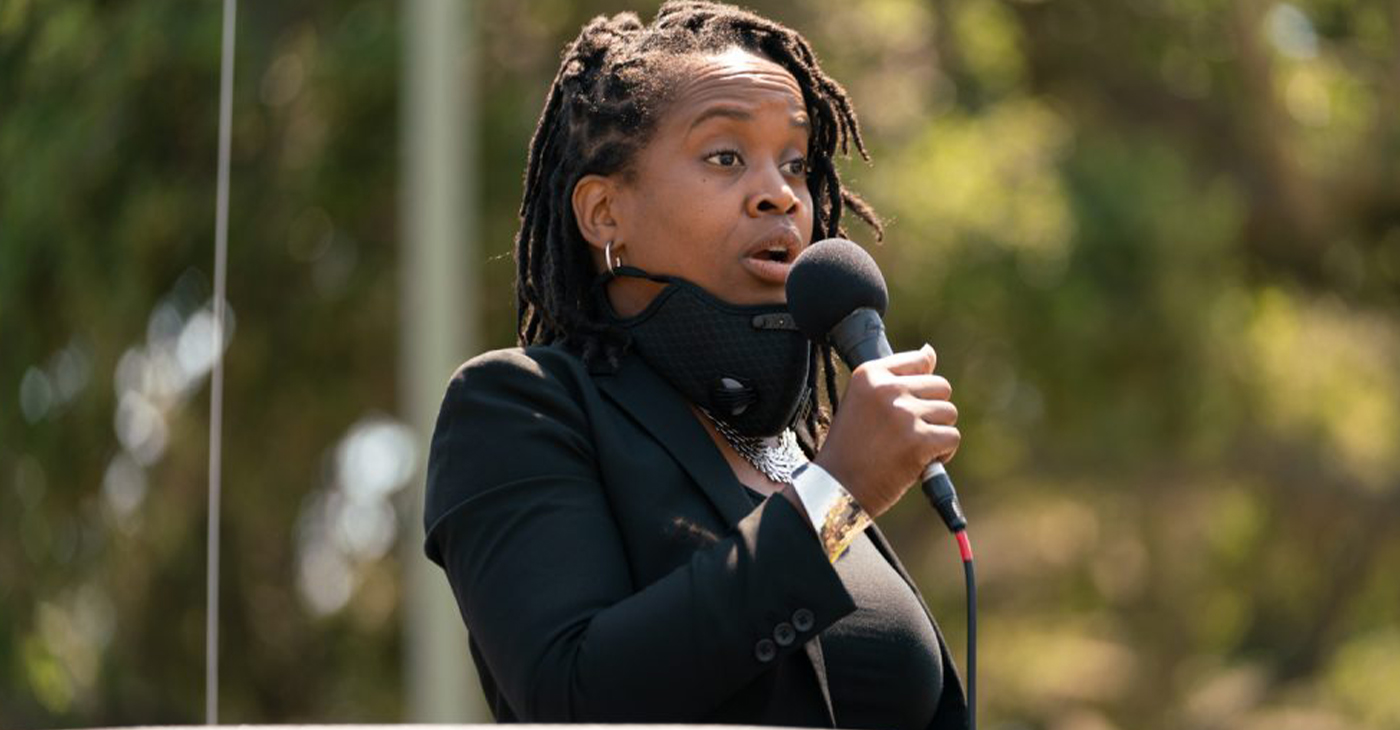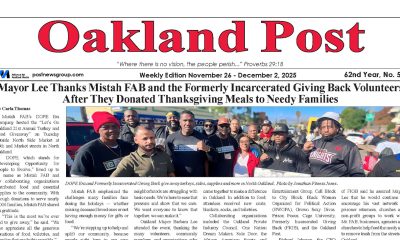Business
Higher Minimum-Wage Proposals Gain Ground on Both Coasts

LISA LEFF, Associated Press
DAVID KLEPPER, Associated Press
SAN FRANCISCO (AP) — The push for a higher minimum wage gained momentum on both sides of the country, with New York embracing an eventual $15 an hour for the state’s 200,000 fast-food workers and the huge University of California system announcing the same raise for its employees.
“How we support our workers and their families impacts Californians who might never set foot on one of our campuses,” UC President Janet Napolitano, who oversees 10 campuses, including UCLA and Berkeley, said of Wednesday’s action. “It’s the right thing to do.”
The 240,000-student University of California becomes the nation’s first public university to commit itself to the $15-an-hour wage that has become the rallying cry of many labor groups in recent months.
So far, the cities of Los Angeles, Seattle, San Francisco, Oakland and Berkeley have approved phased-in increases that eventually will take their minimum wage to $15 an hour, or about $31,200 a year. On Tuesday, Los Angeles County, the nation’s most populous county, voted to craft a law to do the same over five years.
In New York, the state Wage Board Wednesday endorsed a proposal to set a $15 minimum wage for workers at fast-food restaurants with 30 or more locations. The increase would be phased in over three years in New York City and over six years elsewhere.
Gov. Andrew Cuomo’s administration has the final say, and he has signaled his support. New York would become the first state to single out a specific industry for such an increase. The state minimum wage is now $8.75.
“You cannot live and support a family on $18,000 a year in the state of New York — period,” Cuomo said at a New York City rally celebrating the proposal. “This is just the beginning. We will not stop until we reach true economic justice.”
Restaurant owners warned that higher wages could force them to raise prices, cut employee hours and hire fewer workers, and they said they may challenge the move in court.
“Singling out fast-food restaurants while ignoring other industries that hire workers who are paid under $15 is unfair and discriminatory,” said Jack Bert, who owns seven McDonald’s restaurants in New York City.
But Rebecca Cornick, a 60-year-old woman who makes $9 an hour at a Wendy’s in Brooklyn, said, “If I made $15, I could pay my rent on time, I could put food on the table, I could hold my head up.”
At the University of California, the hourly wage earners include students and full-time contract employees who work in dining halls, dorms and bookstores or labor as gardeners, housekeepers and custodians. Many start at the state minimum wage of $9 an hour.
Napolitano said she will boost that to $13 in October for employees who work at least 20 hours a week and will raise it some more in stages to $15 by the fall of 2017.
About 3,200 UC employees and a much larger but undetermined number of people employed by outside contractors at the university will receive the higher wage, UC said. The university is California’s third-largest employer, with a staff of 195,000.
“I just thought it was important for a public university to plant the flag here for low-wage workers and a more livable wage,” said Napolitano, who was President Barack Obama’s homeland security secretary before she assumed leadership of the university nearly two years ago.
Napolitano’s plan does not need approval from the university’s governing Board of Regents.
The higher minimum-wage argument has gained traction amid concerns over the shrinking middle class and rising income inequality.
Supporters argue a higher wage floor will help lift the working poor into the middle class. Opponents warn higher wages will kill jobs and lead to higher prices. Sixteen states have passed laws barring local governments from setting their own minimum wage.
Democrats, including presidential front-runner Hillary Rodham Clinton, have said they support a higher federal minimum wage, which is currently $7.25 per hour.
Vice President Joe Biden promoted a higher minimum wage of at least $12 an hour during a stop Wednesday at a washroom equipment manufacturer in Los Angeles, where he chatted with employees as they assembled soap dispensers.
Biden said the wage hikes approved by the city’s mayor and county supervisors would be “life-changing” for some 700,000 workers in the Los Angeles area.
“Maybe you’ll be able to have meat on the table a couple of times a week instead of once a month,” Biden told workers at Bobrick Washroom Equipment, whose CEO backed the city’s wage ordinance.
Other public university systems, including ones in Washington state, Indiana and Tennessee, have adopted minimum wages higher than those set under state or federal law. But none have committed to going as high as the University of California.
University officials estimated that the raises for workers directly employed by UC will cost $14 million a year, a fraction of the system’s $12.6 billion annual payroll. UC said it also expects contractors will pass some of the cost of higher wages onto the university.
The Republican leader of the California Assembly criticized the university’s plan to extend the higher wage to outside contractors.
“The university should be teaching engineering, not spending student dollars to practice social engineering by limiting who campuses can do businesses with,” Assemblywoman Kristen Olsen said.
In Washington, D.C., meanwhile, election officials approved the language of a proposed ballot measure that would make the nation’s capital the first East Coast city to adopt a $15 minimum wage. Supporters will have to gather about 23,000 signatures to get the proposal on next year’s ballot.
___
Klepper reported from Albany, N.Y. Associated Press writer Robert Jablon in Los Angeles contributed to this story.
___
This story has been corrected to show that the number of affected university employees is about 3,200 instead of 4,200.
Copyright 2015 The Associated Press. All rights reserved. This material may not be published, broadcast, rewritten or redistributed.
Activism
Lu Lu’s House is Not Just Toying Around with the Community
Wilson and Lambert will be partnering with Mayor Barbara Lee on a toy giveaway on Dec. 20. Young people, like Dremont Wilkes, age 15, will help give away toys and encourage young people to stay in school and out of trouble. Wilkes wants to go to college and become a specialist in financial aid. Sports agent Aaron Goodwin has committed to giving all eight young people from Lu Lu’s House a fully paid free ride to college, provided they keep a 3.0 grade point average and continue the program. Lu Lu’s House is not toying around.

Special to the Post
Lu Lu’s House is a 501c3 organization based in Oakland, founded by Mr. Zirl Wilson and Mr. Tracy Lambert, both previously incarcerated. After their release from jail, they wanted to change things for the better in the community — and wow, have they done that!
The duo developed housing for previously incarcerated people, calling it “Lu Lu’s House,” after Wilson’s wonderful wife. At a time when many young people were robbing, looting, and involved in shootings, Wilson and Lambert took it upon themselves to risk their lives to engage young gang members and teach them about nonviolence, safety, cleanliness, business, education, and the importance of health and longevity.
Lambert sold hats and T-shirts at the Eastmont Mall and was visited by his friend Wilson. At the mall, they witnessed gangs of young people running into the stores, stealing whatever they could get their hands on and then rushing out. Wilson tried to stop them after numerous robberies and finally called the police, who Wilson said, “did not respond.” Having been incarcerated previously, they realized that if the young people were allowed to continue to rob the stores, they could receive multiple criminal counts, which would take their case from misdemeanors to felonies, resulting in incarceration.

Lu Lu’s House traveled to Los Angeles and obtained more than 500 toys
for a Dec. 20 giveaway in partnership with Oakland Mayor Barbara
Lee. Courtesy Oakland Private Industry,
Wilson took it upon himself to follow the young people home and when he arrived at their subsidized homes, he realized the importance of trying to save the young people from violence, drug addiction, lack of self-worth, and incarceration — as well as their families from losing subsidized housing. Lambert and Wilson explained to the young men and women, ages 13-17, that there were positive options which might allow them to make money legally and stay out of jail. Wilson and Lambert decided to teach them how to wash cars and they opened a car wash in East Oakland. Oakland’s Initiative, “Keep the town clean,” involved the young people from Lu Lu’s House participating in more than eight cleanup sessions throughout Oakland. To assist with their infrastructure, Lu Lu’s House has partnered with Oakland’s Private Industry Council.
For the Christmas season, Lu Lu’s House and reformed young people (who were previously robbed) will continue to give back.
Lu Lu’s House traveled to Los Angeles and obtained more than 500 toys.
Wilson and Lambert will be partnering with Mayor Barbara Lee on a toy giveaway on Dec. 20. Young people, like Dremont Wilkes, age 15, will help give away toys and encourage young people to stay in school and out of trouble. Wilkes wants to go to college and become a specialist in financial aid. Sports agent Aaron Goodwin has committed to giving all eight young people from Lu Lu’s House a fully paid free ride to college, provided they keep a 3.0 grade point average and continue the program. Lu Lu’s House is not toying around.
Activism
Desmond Gumbs — Visionary Founder, Mentor, and Builder of Opportunity
Gumbs’ coaching and leadership journey spans from Bishop O’Dowd High School, Oakland High School, Stellar Prep High School. Over the decades, hundreds of his students have gone on to college, earning academic and athletic scholarships and developing life skills that extend well beyond sports.

Special to the Post
For more than 25 years, Desmond Gumbs has been a cornerstone of Bay Area education and athletics — not simply as a coach, but as a mentor, founder, and architect of opportunity. While recent media narratives have focused narrowly on challenges, they fail to capture the far more important truth: Gumbs’ life’s work has been dedicated to building pathways to college, character, and long-term success for hundreds of young people.
A Career Defined by Impact
Gumbs’ coaching and leadership journey spans from Bishop O’Dowd High School, Oakland High School, Stellar Prep High School. Over the decades, hundreds of his students have gone on to college, earning academic and athletic scholarships and developing life skills that extend well beyond sports.
One of his most enduring contributions is his role as founder of Stellar Prep High School, a non-traditional, mission-driven institution created to serve students who needed additional structure, belief, and opportunity. Through Stellar Prep numerous students have advanced to college — many with scholarships — demonstrating Gumbs’ deep commitment to education as the foundation for athletic and personal success.

NCAA football history was made this year when Head Coach from
Mississippi Valley State, Terrell Buckley and Head Coach Desmond
Gumbs both had starting kickers that were women. This picture was
taken after the game.
A Personal Testament to the Mission: Addison Gumbs
Perhaps no example better reflects Desmond Gumbs’ philosophy than the journey of his son, Addison Gumbs. Addison became an Army All-American, one of the highest honors in high school football — and notably, the last Army All-Americans produced by the Bay Area, alongside Najee Harris.
Both young men went on to compete at the highest levels of college football — Addison Gumbs at the University of Oklahoma, and Najee Harris at the University of Alabama — representing the Bay Area on a national level.
Building Lincoln University Athletics From the Ground Up
In 2021, Gumbs accepted one of the most difficult challenges in college athletics: launching an entire athletics department at Lincoln University in Oakland from scratch. With no established infrastructure, limited facilities, and eventually the loss of key financial aid resources, he nonetheless built opportunities where none existed.
Under his leadership, Lincoln University introduced:
- Football
- Men’s and Women’s Basketball
- Men’s and Women’s Soccer
Operating as an independent program with no capital and no conference safety net, Gumbs was forced to innovate — finding ways to sustain teams, schedule competition, and keep student-athletes enrolled and progressing toward degrees. The work was never about comfort; it was about access.
Voices That Reflect His Impact
Desmond Gumbs’ philosophy has been consistently reflected in his own published words:
- “if you have an idea, you’re 75% there the remaining 25% is actually doing it.”
- “This generation doesn’t respect the title — they respect the person.”
- “Greatness is a habit, not a moment.”
Former players and community members have echoed similar sentiments in public commentary, crediting Gumbs with teaching them leadership, accountability, confidence, and belief in themselves — lessons that outlast any single season.
Context Matters More Than Headlines
Recent articles critical of Lincoln University athletics focus on logistical and financial hardships while ignoring the reality of building a new program with limited resources in one of the most expensive regions in the country. Such narratives are ultimately harmful and incomplete, failing to recognize the courage it takes to create opportunity instead of walking away when conditions are difficult.
The real story is not about early struggles — it is about vision, resilience, and service.
A Legacy That Endures
From founding Stellar PREP High School, to sending hundreds of students to college, to producing elite athletes like Addison Gumbs, to launching Lincoln University athletics, Desmond Gumbs’ legacy is one of belief in young people and relentless commitment to opportunity.
His work cannot be reduced to headlines or records. It lives on in degrees earned, scholarships secured, leaders developed, and futures changed — across the Bay Area and beyond.
Activism
Black Arts Movement Business District Named New Cultural District in California
Located in the heart of District 3, the BAMBD is widely regarded as one of the nation’s most important centers of Black cultural production — a space where artists, entrepreneurs, organizers, and cultural workers have shaped generations of local and national identity. The state’s recognition affirms the district’s historic importance and its future promise.

By Post Staff
Oakland’s Black Arts Movement Business District (BAMBD) has been selected as one of California’s 10 new state-designated Cultural Districts, a distinction awarded by the California Arts Council (CAC), according to a media statement released by Councilmember Carroll Fife.
The BAMBD now joins 23 other districts across the state recognized for their deep cultural legacy, artistic excellence, and contributions to California’s creative economy.
Located in the heart of District 3, the BAMBD is widely regarded as one of the nation’s most important centers of Black cultural production — a space where artists, entrepreneurs, organizers, and cultural workers have shaped generations of local and national identity. The state’s recognition affirms the district’s historic importance and its future promise.
“This designation is a testament to what Black Oakland has built — and what we continue to build when we insist on investing in our own cultural and economic power,” said Fife.
“For years, our community has fought for meaningful recognition and resources for the Black Arts Movement Business District,” she said. “This announcement validates that work and ensures that BAMBD receives the support it needs to grow, thrive, and continue shaping the cultural fabric of California.”
Since taking office, Fife has led and supported multiple initiatives that strengthened the groundwork for this achievement, including:
- Restoring and protecting arts and cultural staffing within the City of Oakland.
- Creating the West Oakland Community Fund to reinvest in historically excluded communities
- Advancing a Black New Deal study to expand economic opportunity for Black Oakland
- Ensuring racial equity impact analyses for development proposals, improving access for Black businesses and Black contractors
- Introduced legislation and budget amendments that formalized, protected, and expanded the BAMBD
“These efforts weren’t abstract,” Fife said. “They were intentional, coordinated, and rooted in a belief that Black arts and Black businesses deserve deep, sustained public investment.”
As part of the Cultural District designation, BAMBD will receive:
- $10,000 over two years
- Dedicated technical assistance
- Statewide marketing and branding support
- Official designation from Jan. 1, 2026, through Dec. 31, 2030
This support will elevate the visibility of BAMBD’s artists, cultural organizations, small businesses, and legacy institutions, while helping attract new investment to the district.
“The BAMBD has always been more than a district,” Fife continued. “This recognition by the State of California gives us another tool in the fight to preserve Black culture, build Black economic power, and protect the families and institutions that make Oakland strong.”
For questions, contact Councilmember Carroll Fife at CFife@oaklandca.gov.
-

 Activism4 weeks ago
Activism4 weeks agoOakland Post: Week of November 19 – 25, 2025
-

 #NNPA BlackPress3 weeks ago
#NNPA BlackPress3 weeks agoLIHEAP Funds Released After Weeks of Delay as States and the District Rush to Protect Households from the Cold
-

 Alameda County3 weeks ago
Alameda County3 weeks agoSeth Curry Makes Impressive Debut with the Golden State Warriors
-

 Activism3 weeks ago
Activism3 weeks agoOakland Post: Week of November 26 – December 2, 2025
-

 #NNPA BlackPress3 weeks ago
#NNPA BlackPress3 weeks agoSeven Steps to Help Your Child Build Meaningful Connections
-

 #NNPA BlackPress4 weeks ago
#NNPA BlackPress4 weeks agoBeyoncé and Jay-Z make rare public appearance with Lewis Hamilton at Las Vegas Grand Prix
-

 #NNPA BlackPress3 weeks ago
#NNPA BlackPress3 weeks agoSeven Steps to Help Your Child Build Meaningful Connections
-

 #NNPA BlackPress3 weeks ago
#NNPA BlackPress3 weeks agoTrinidad and Tobago – Prime Minister Confirms U.S. Marines Working on Tobago Radar System






















































